
Mass Wasting
Geologists use the term landslide in a general sense to cover a wide variety of mass movements that may cause loss of life, property damage, or a general disruption of human activities. In 218 B.C., Avalanches in the European Alps buried 18,000 people; an earthquake-generated landslide in Hsian, China, killed an estimated 1,000,000 people in 1556; and 7,000 people died when mudflows and avalanches destroyed Huaraz, Peru, in 1941. What makes these mass movements so terrifying, and yet so fascinating, is that they almost always occur with little or no warning and are over in a very short time, leaving behind a legacy of death and destruction.
Mass wasting (also called mass movement) is defined as the downslope movement of material under the direct influence of gravity. Most types of mass wasting are aided by weathering and usually involve surficial (surface) materials. The material moves at rates ranging from almost imperceptible, as in the case of creep, to extremely fast as in a rockfall or slide. Though water can play an important role, the relentless pull of gravity is the major force behind mass wasting.
Factors Influencing Mass Wasting
When the gravitational force acting on a slope exceeds its resisting force, slope failure (mass wasting) occurs. The resisting forces helping to maintain slope stability include the slope material's strength and cohesion, the amount of internal friction between grains, and any external support of the slope. These factors collectively define a slope's shear strength.

Opposing a slope's shear strength is the force of gravity. Gravity operates vertically but has a component acting parallel to slope, thereby causing instability. The greater a slope's angle, the greater the chance for mass wasting. The steepest angle that a slope can maintain without collapsing is its angle of repose. At this angle, the shear strength of the slope's material exactly counterbalance the force of gravity. For unconsolidated material, the angle of repose normally ranges from 25 to 40 degrees. Slopes steeper than 40 degrees usually consist of unweathered solid rock.
All slopes are in a state of dynamic equilibrium, which means that they are constantly adjusting to new conditions. While we tend to view mass wasting as a disruptive and usually destructive event, it is one of the ways that a slope adjusts to new conditions.
Many factors can cause mass wasting: a change in slope gradient, weakening of materials by weathering, increased water content, changes in the vegetation cover, and overloading. Although most of these are interrelated, we will examine them separately for ease of discussion, but will also show how they individually and collectively affect a slope's equilibrium.
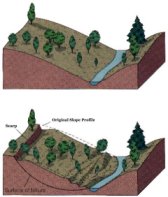
Slope Gradient
Slope gradient is probably the major cause of mass wasting. Generally speaking, the steeper the slope, the less stable it is. Therefore, steep slopes are more likely to experience mass wasting than gentle ones.
A number of processes can oversteepen a slope. One of the most common is undercutting by stream or wave action. This removes the slope's base, increases the slope angle, and thereby increases the gravitational force acting parallel to the slope. Wave action, especially during storms, often result in mass movements along the shores of oceans or large lakes.
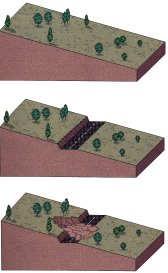
Excavations for road cuts and hillside building sites are another major cause of slope failure. Grading the slope too steeply, or cutting into its side, increases the stress in rock or soil until it is no longer strong enough to remain at the steeper angle and mass wasting ensues. Such action is analogous to undercutting by streams or waves and has the same result, thus explaining why so many mountain roads are plagued by frequent mass movements. Fortunately, many of the slope failures associated with hillside road cuts and building construction can be avoided or greatly minimized by better understanding of the factors involved.
Weathering and Climate
Mass wasting is more likely to occur in loose or poorly consolidated slope material than in solid bedrock. As soon as solid rock is exposed at the Earth's surface, weathering begins to disintegrate and decompose it, thereby reducing its shear strength and increasing its susceptibility to mass wasting. The deeper the weathering zone extends, the greater the likelihood of some type of mass movement.
Some rocks are more susceptible to weathering than others and climate plays an important role in the rate and type of weathering. In the tropics, where temperatures are high and considerable rainfall occurs, the effects of weathering extend to depths of several tens of meters, and rapid mass movements most commonly occur in the deep weathering zone. In arid and semiarid regions, the weathering zone is usually considerably shallower. Nevertheless, localized and intense cloud-bursts can drop large quantities of water on an area in a short time. With little vegetation to absorb this water, runoff is rapid and frequently results in mudflows. In high mountains, rockfalls are common because of frost action.
Water Content
The amount of water in rock or soil influences slope stability. Large quantities of water from melting snow or heavy storms greatly increase the likelihood of slope failure. The additional weight that water adds to a slope can be enough to cause mass movement. Furthermore, water percolating through a slope's material helps to decrease friction between grains, contributing to a loss of cohesion. For example, slopes composed of dry clay are usually quite stable, but when wet, they can quickly lose cohesiveness and internal friction and become an unstable slurry. This occurs because clay, which can hold large quantities of water, consists of platy particles that easily slide over each other when wet. For this reason, clay beds are frequently the slippery layer along which overlying rock units slide downslope.
Vegetation
Vegetation affects slope stability in several ways. By absorbing the water from a rainstorm, vegetation decreases water saturation of a slope's material and the resultant loss of shear strength that frequently leads to mass wasting. In addition, the root system of vegetation helps to stabilize a slope by binding soil particles together and holding the soil to bedrock.
The removal of vegetation by either natural or human activity is a major cause of many mass movements. Summer brush and forest fires in southern California, for example, frequently leave the hillsides bare of vegetation. Fall rainstorms saturate the ground causing mudslides that do tremendous damage.
Overloading
Overloading is almost always the result of human activity and typically results from dumping, filling, or piling up of material. Under natural conditions, a material's load is carried by its grain-to-grain contacts, and a slope is thus maintained by the friction between grains. The additional weight created by overloading increases the water pressure within the material, which in turn decreases its shear strength, thereby weakening the slope material. If enough material is added, the slope will eventually fail, sometimes with tragic consequences.
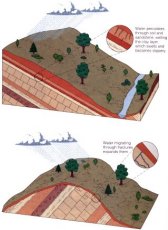
Geology and Slope Stability
The relationship between topography and the geology of an area is important in determining slope stability. If the rocks underlying a slope dip in the same direction as the slope, mass wasting is more likely to occur than if the rocks are horizontal or dip in the opposite direction. When the rocks dip in the same direction as the slope, water can percolate along the various bedding planes and decrease the cohesiveness and friction between adjacent rock layers. This is particularly true when there are interbedded clay layers because clay becomes very slippery when wet.
Even if the rocks are horizontal or dip in a direction opposite to that of the slope, joints (water pathways underground 'expand when wet') may travel in the same direction as the slope. Water migrating through them weathers the rock and expands these openings until the weight of the overlying rocks cause it to fall.
Triggering Mechanisms
While the factors previously discussed all contribute to slope instability, most, though not all, rapid mass movements are triggered by a force that temporarily disturbs slope equilibrium. The most common triggering mechanisms are strong vibrations from earthquakes and excessive amounts of water from a winter snow melt or a heavy rainstorm.
Volcanic eruptions, explosions, and even loud claps of thunder may also be enough to trigger a landslide if the slope is sufficiently unstable. Many avalanches, which are rapid movements of snow and ice down steep mountain slopes, are triggered by the sound of a loud gunshot, a sonic boom from a super sonic airplane, or, in rare cases, even a person's shout.
Types of Mass Wasting
Geologists recognize a variety of mass movements. Some are of one distinct type, while others are a combination of different types. It is not uncommon for one type of mass movement to change into another along its course. A landslide, for example, may start out as a slump at its head and, with the addition of water, become an earthflow at its base. Even though many slope failures are combinations of different materials and movements, it is still convenient to classify them according to their dominant behavior.
Mass movements are generally classified on the basis of the major criteria 1) rate of movement (rapid or slow); 2) type of movement (primarily falling, sliding, or flowing); and 3) type of material involved (rock, soil, or debris).
Rapid mass movements involve a visible movement of material. Such movements usually occur quite suddenly, and the material moves very quickly downslope. Rapid mass movements are potentially dangerous and frequently result in loss of life and property damage. Most rapid mass movements occur on relatively steep slopes and can involve rock, soil, or debris.
Slow mass movements advance at an imperceptible rate and are usually only detectable by the effects of their movements such as tilted trees, power poles, or cracked foundations. Although rapid mass movements are more dramatic, slow mass movements are responsible for the downslope transport of a much greater volume of weathered material.
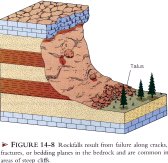
Falls
Rockfalls are a common type of extremely rapid mass movement in which rocks of any size fall through the air. Rockfalls occur along steep canyons, cliffs, and road cuts and build up accumulations of loose rocks and rock fragments at their base called talus.
Rockfalls result from failure along joints or bedding planes in the bedrock and are commonly triggered by natural or human undercutting of slopes, or by earthquakes. Many rockfalls in cold climates are the result of frost wedging. Chemical weathering caused by water percolating through fissures in carbonate rocks (limestone, dolostone, and marble) is also responsible for many rockfalls.
Rockfalls range in size from small rocks falling from a cliff to massive falls involve millions of cubic meters of debris that destroy buildings, bury towns, and block highways. Rockfalls are a particular common hazard in mountainous areas where roads have been built by blasting and grading through steep hillsides of bedrock. Anyone who has ever driven through the Appalachians, the Rocky Mountains, or the Sierra Nevada is familiar with the "Watch for Falling Rocks" signs posted to warn drivers of the danger. Slopes particularly prone to rockfalls are sometimes covered with wire mesh in an effort to prevent dislodged rocks from falling to the road below. Another tactic is to put up wire mesh fences along the base of the slope to catch or slow down bouncing or rolling rocks.
Slides
A slide involves movement of material along one or more surfaces of failure. The type of material may be soil, rock, or a combination of the two, and it may break apart during movement or remain intact. A slide's rate of movement can vary from extremely slow to very rapid.
Two types of slides are generally recognized: 1) slumps or rotational slides, in which movement occurs along a curved surface; and 2) rock or block glides, which move along a more or less planar surface.
A slump involves the downward movement of material along a curved surface of rupture and is characterized by the backward rotation of the slump block. Slumps occur most commonly in unconsolidated or weakly consolidated material and range in size from a small individual sets, such as occur along stream banks, to massive, multiple sets that affect large areas and cause considerable damage.
Slumps can be caused by a variety of factors, but the most common is erosion along the base of a slope, which removes support for the overlying material. This local steepening may be caused naturally by stream erosion along its banks or by wave action at the base of a coastal cliff. Slope oversteepening can also be caused by human activity, such as the construction of highways and housing developments. Slumps are particularly prevalent along highway cuts where they are generally the most frequent type of slope failure observed.
While many slumps are merely a nuisance, large-scale slumps involving populated areas and highways can cause extensive damage. Such is the case in coastal southern California where slumping and sliding have been a constant problem. Many areas along the coast are underlain by poorly to weakly consolidated silts, sands, and gravels interbedded with clay layers, some of which are weathered ash falls. In addition, southern California is tectonically active so that many of these deposits are cut by faults and joints, which allow the infrequent rains to percolate downward rapidly, wetting and lubricating the clay layers.

A rock or block glide occurs when rocks move downslope along a more or less planar surface. Most rock glides occur because the local slopes and rock layers dip in the same direction, although they can also occur along fractures parallel to a slope.
The largest know rock glide in the world is the prehistoric Saidmarreh landslide in southwestern Iran. A slab of limestone 305m thick, 14km long, and 5km wide became detached from the Kabir kuh ridge and slid down and across the adjacent 8km wide Saidmarreh Valley with enough momentum to climb over a ridge 460m high before stopping nearly 18km from its source! The volume of the slipped material was about 21km^3, and it weighed approximately 50 billion tons. When the debris from the rock glide finally settled, it covered an area of 166km^2.
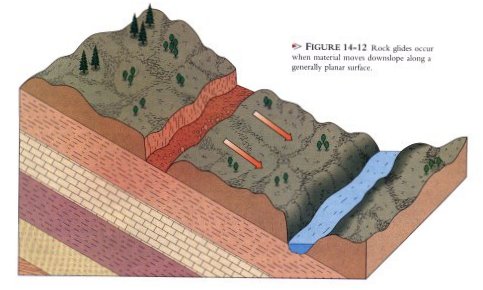
Flows
Mass movements in which material flows as a viscous fluid or displays plastic movement are termed flows. Their rate of movements ranges from extremely slow to extremely rapid. In many cases, mass movements may begin as falls, slumps, or slides and change into flows further downslope.
Mudflows are the most fluid of the major mass movement types. They consist of at least 50% silt and clay sized material combined with a significant amount of water (up to 30%). Mudflows are common in arid and semiarid regions where they are triggered by heavy rainstorms that quickly saturate the regolist, turning it into a raging flow of mud that engulfs everything in its path. Mudflows can also occur in mountain regions and in areas covered by volcanic ash where they can be particularly destructive. Because mudflows are so fluid, they generally follow a preexisting channels until the slope decreases or the channel widens, at which point the fan out.
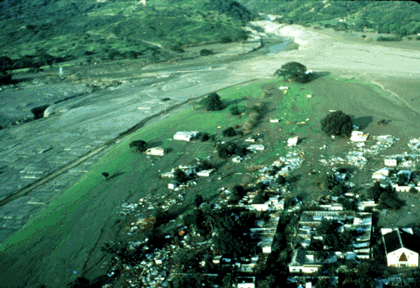
Debris flows are composed of larger-sized particles than those in mudflows and do not contain as much water. Consequently, they are usually more viscous than mudflows, typically do not move as rapidly, and rarely are confined to preexisting channels. Debris flows can, however, be just as damaging because they can transport large objects.
Earthflows move more slowly than either mudflows or debris flows. An earthflow slumps from the upper part of a thick, viscous, tongue-shaped mass of wet regolith. Like mudflows and debris flows, earthflows can be of any size, and are frequently destructive. They occur most commonly in humid climates on grassy soil-covered slopes following heavy rains.
Some clays spontaneously liquefy and flow like water when they are disturbed. Such quick clays have caused serious damage and loss of lives in Sweden, Norway, eastern Canada, and Alaska. Quick clays are composed of silt and clay particles made by the grinding action of glaciers. Geologists think these fine sediments were originally deposited in a marine environment where their pore space was filled with salt water. The ions in the salt water helped establish strong bonds between the clay particles, thus stabilizing and strengthening the clay. When the clays were subsequently uplifted above sea level, however, the salt water was flushed out by fresh groundwater, reducing the effectiveness of the ionic bonds between the clay particles and thereby reducing the overall strength and cohesiveness of the clay. Consequently, when the clay is disturbed by a sudden shock or shaking, it essentially turns to a liquid and flows.
Solifluction is the slow downslope movement of water-saturated surface sediment. Solifluction can occur in any climate where the ground becomes saturated with water, but is most common in cold climates where the upper surface periodically thaws and freezes. Permafrost is ground that remains permanently frozen. It covers nearly 20% of the world's land surface. During the warmer season when the upper portion of the permafrost thaws, water and surface sediments form a soggy mass that flows by solifluction and produces a characteristic lobate topography.
Creep is the slowest type of flow. It is also the most widespread and significant mass wasting process in terms of the total amount of material moved downslope and the monetary damage that it does annually. Creep involves extremely slow downhill movement of soil or rock under the inexorable pull of gravity. Although in can occur anywhere and in any climate, it is most effective and significant as a geologic agent in humid regions. In fact, it is the most common form of mass wasting in the southeastern United States and the southern Appalachian Mountains.
Because the rate of movement is essentially imperceptible, we are frequently unaware of creep's existence until we notice its effects: tilted trees and power poles, broken streets and sidewalks, and cracked retaining walls or foundations. Creep usually involves the whole hillside and probably occurs, to some extent, on any weathered or soil-covered, sloping surface.
Complex Movements
Many mass movements are combinations of different movement types. When one type is dominant, the movement can be classified as one of the movements described so far. If several types are more or less equally involved, it is called a complex movement.
The most common type of complex movement is the slide-flow in which there is sliding at the head and then some type of flowage farther along its course. Most slide-flow landslides involve well-defined slumping at the head, followed by a debris flow or earthflow. Any combination of different mass movement types can be classified as a complex movement.

A debris avalanche is a complex movement that often occurs in very steep mountain ranges. Debris avalanches typically start out as rockfalls when large quantities of rock, ice, and snow are dislodged from a mountainside, frequently as a result of an earthquake. The material then slides or flows down the mountainside, picking up additional surface material and increasing in speed and momentum.